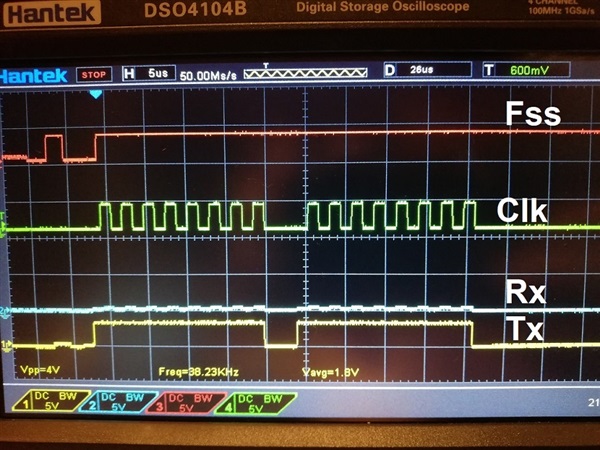I am using the TivaWare libraries. I intend to send two bytes of data (0xFF, 0xFF) over SSI2 in the SPI protocol, with the Fss signal to be low for the duration of the two-byte frame. Upon realising that the TM4C123GH6PM does not support SSIAdvFrameHoldEnable(uint32_t ui32Base), I decided to manually take control of the SSI2Fss (PB5) signal as a GPIO output.
However, the Fss signal is not behaving as I intended. It goes high at the beginning of the first byte, and stays high. I have stepped through my code, and have monitored the GPIO PORTB DATA register throughout. That register behaves as it should but my resultant waveform does not correspond to the register value.
Please shed some light on this issue. I have attached my code and the captured waveform for your reference. Thank you for your time.
void SSI2Init(void) {
SysCtlPeripheralEnable(SYSCTL_PERIPH_SSI2);
SysCtlPeripheralEnable(SYSCTL_PERIPH_GPIOB);
GPIOPinConfigure(GPIO_PB4_SSI2CLK);
GPIOPinConfigure(GPIO_PB6_SSI2RX);
GPIOPinConfigure(GPIO_PB7_SSI2TX);
GPIOPinTypeSSI(GPIO_PORTB_BASE, GPIO_PIN_4 | GPIO_PIN_6 |
GPIO_PIN_7);
SSIConfigSetExpClk(SSI2_BASE, SysCtlClockGet(), SSI_FRF_MOTO_MODE_0,
SSI_MODE_MASTER, 350000, 8);
SSIEnable(SSI2_BASE);
uint32_t RxBuffer;
// Flush receive FIFO buffer of any residual data and discard it
while (SSIDataGetNonBlocking(SSI2_BASE, &RxBuffer)) {
}
GPIOPinTypeGPIOOutput(GPIO_PORTB_BASE, GPIO_PIN_5);
GPIOPinWrite(GPIO_PORTB_BASE, GPIO_PIN_5, GPIO_PIN_5);
return;
}
void SDCardInit(void) {
uint32_t TxBuffer = 0xFF;
GPIOPinWrite(GPIO_PORTB_BASE, GPIO_PIN_5, 0);
SSIDataPut(SSI2_BASE, TxBuffer);
SSIDataPut(SSI2_BASE, TxBuffer);
GPIOPinWrite(GPIO_PORTB_BASE, GPIO_PIN_5, GPIO_PIN_5);
}
/**
* main.c
*/
int main(void)
{
uint32_t RxBuffer;
uint32_t TxBuffer;
InitConsole();
UARTprintf("SysCtlClockGet(): %u\n", SysCtlClockGet());
SSI2Init();
SDCardInit();
while (1) {
}
return 0;
}


